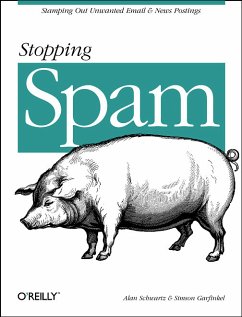This is a book about spam -- unwanted email messages and inappropriate news articles -- and what you can do to prevent it, stop it, and even outlaw it. It's a book for people who have seen their mailboxes fill up with useless messages and unsolicited advertisements, and who are tired of footing the bill for them in their Internet service charges. It's a book for people who are upset that they can't find the on-topic postings in their once-helpful newsgroups, and fear that the community of newsgroup readers will dissolve in disgust.
Stopping Spam looks at the problem of spam and explains ways you can eliminate unwanted messages and news postings. It provides information of use to individual users (who don't want to be bothered by spam) and to system administrators (also news administrators, mail administrators, and network administrators, who are responsible for minimizing spam problems within their organizations or service providers). It covers:
* Introduction to spam: what is it, why is it a problem, who are the spammers and why do they do it, what are the types of spam (spam that sells things, spam that contains political messages, spam that hurts people's reputations), what is its history, what is its impact on the Internet now and in the future?
* Internet messaging: a brief look at the technical underpinnings of Internet messaging to explain how email and spam work.* * User's guides to email and news spam: how to protect your email address, filter email and news articles, and respond to spam.* * Administrator's guide: how to trace spam, make policy choices for your site, block both incoming and outgoing spam, and select the right technical tools.* * Community responses: how to join forces to defeat spam. There are many possible responses to spam: simply delete it, complain to spammers and/or their service providers, share information, trap spammers, litigate, campaign for legislative solutions, use the media.* * Other resources: offline and online documents, tools, mailing lists, and more.*
Stopping Spam looks at the problem of spam and explains ways you can eliminate unwanted messages and news postings. It provides information of use to individual users (who don't want to be bothered by spam) and to system administrators (also news administrators, mail administrators, and network administrators, who are responsible for minimizing spam problems within their organizations or service providers). It covers:
* Introduction to spam: what is it, why is it a problem, who are the spammers and why do they do it, what are the types of spam (spam that sells things, spam that contains political messages, spam that hurts people's reputations), what is its history, what is its impact on the Internet now and in the future?
* Internet messaging: a brief look at the technical underpinnings of Internet messaging to explain how email and spam work.* * User's guides to email and news spam: how to protect your email address, filter email and news articles, and respond to spam.* * Administrator's guide: how to trace spam, make policy choices for your site, block both incoming and outgoing spam, and select the right technical tools.* * Community responses: how to join forces to defeat spam. There are many possible responses to spam: simply delete it, complain to spammers and/or their service providers, share information, trap spammers, litigate, campaign for legislative solutions, use the media.* * Other resources: offline and online documents, tools, mailing lists, and more.*

